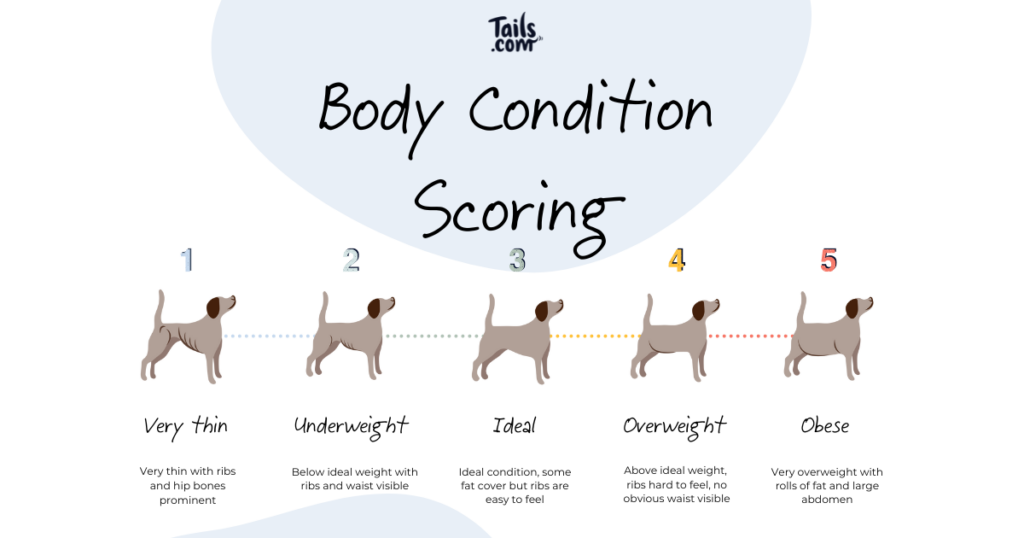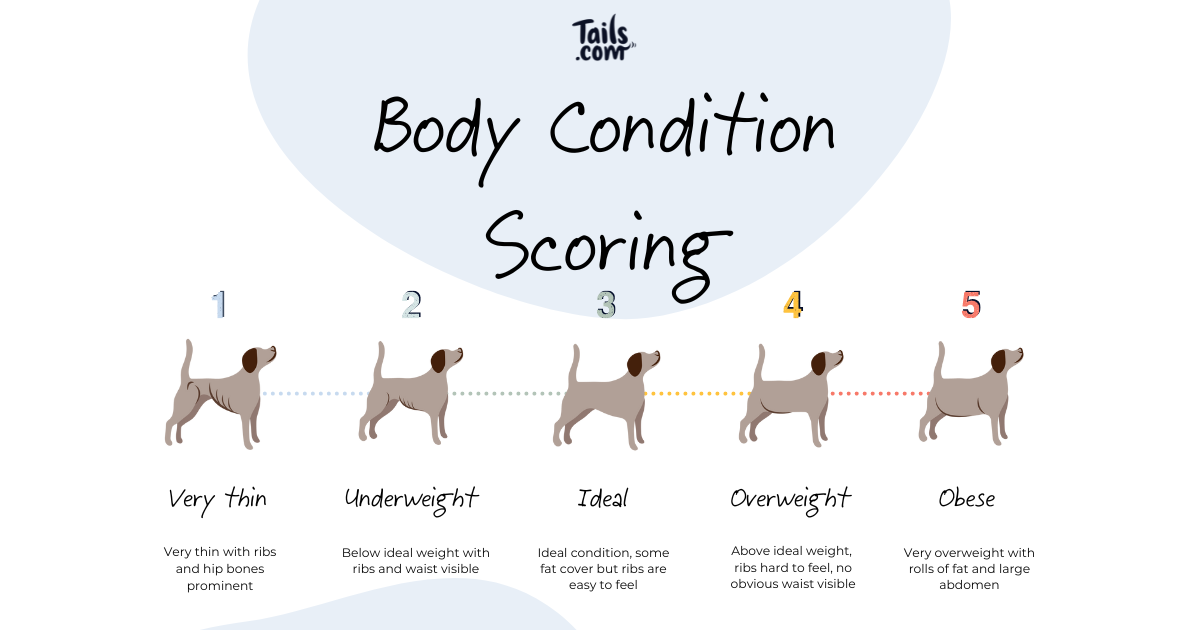Among other things, making sure your dog maintains a healthy weight is an important part of responsible dog ownership. Being overweight or underweight can increase the risk of health problems for your dog and even limit their lifespan. With obesity on the rise in pets, dog owners need to know how to ensure their dogs are in shape.
Many owners keep track of their dog’s weight by checking it on the scales. Whilst this is a great way to monitor weight, it doesn’t always give a true reflection of your dog’s health. Within breeds, sizes of dogs can vary and some can be heavier than others, even when they’re in ideal condition. Along with weighing your pet regularly, it’s advisable for owners to learn how to Body Condition Score (BCS) their dog.
Measuring your dog’s body condition score
Body Condition Scoring is a really useful way to assess whether your dog is a healthy weight for their breed and size. By getting hands-on and assessing three key areas, you can work out if they’re underweight, overweight or in ideal condition. The three areas to examine and feel are:
- Ribs
- Belly
- Waist
Once you’ve assessed these three areas, you give them a score on a five-point scale:
1 = Severely underweight
2 = Underweight
3 = Ideal condition
4 = Overweight
5 = Obese

Here’s how to score your dog’s ribs, belly and waist to find out their Body Condition Score:
Ribs
What to do
Run your fingers over your dog’s rib cage, on either side of their chest in a head to tail direction.
What should you feel?
You should be able to feel the ribs with a slight covering of muscle over them. But they shouldn’t be visible, feel like sharp ridges or be poking out. It’s important to really feel them with your fingertips rather than just looking, as many dogs’ coats will hide the ribs from view.
Low body condition scoring
If your dog is underweight, their ribs will protrude and feel sharp or bumpy as you run your hands along them. If this is the case, it’ll mean a lower BCS.
High body condition scoring
If your dog is overweight, the ribs will be difficult to feel as they will be covered in a layer of fat and muscle. The deeper the ribs are to feel under this layer, the more overweight your dog is and the higher the BCS.
Belly
What to do
Run your hand along your dog’s underside, again from head to tail and look at the belly from the side.
What should you feel?
The belly or undercarriage should start low to the ground where it meets the sternum (or breastbone) at the bottom of the rib cage. Then it should slope higher the further back towards the hips you run your hands on either side.
Low body condition scoring
An underweight dog with a lower BCS will have a very pronounced ‘tummy tuck’ up towards the hips and groin.
High body condition scoring
If the belly droops or hangs down near the floor all the way along and doesn’t tuck up underneath the hips, then your dog may be carrying excess weight and have a higher BCS.
Waist
What to do
Looking down on your dog’s waist and hips from above, you should notice this area is much narrower than the width of the chest and ribcage.
What should you feel?
A slowly tapering abdomen leading from the wider chest to a narrow waist is the sign of ideal condition.
Low body condition scoring
An underweight dog will have a noticeably narrow waist and the bones of the hips and spine may be easily visible and can be felt protruding under the skin. The more pronounced these bony projections, the more underweight they are and hence the lower their BCS.
High body condition scoring
In overweight or obese dogs, the waist does not narrow towards the hips. The trunk or abdomen will often be just as wide as the chest, giving them a barrel-shaped appearance. In dogs with a very high BCS, there may even be fat pads at the waist which stick out even further than the width of the chest when viewed from above.
Actions to take based on your dog’s body condition score
Once you’ve assessed all three areas, you can give your dog a score on the scale from 1-5, to truly determine if they are at a healthy weight for their size. If they’re not at an ideal BCS (a score of 3), then you can alter their portions or diet plan to get them back to healthy condition.
During sign-up at tails.com, we ask you to do a quick Body Condition Score along with telling us their weight and activity level so we can accurately calculate their calorie requirement. This ensures they always remain in a good and healthy condition, which will mean a longer and healthier life for your dog.
Like most things, practice makes perfect and practising the Body Condition Scoring will make sure that you know your dog’s ideal condition. If your dog needs a little help getting back in shape, you can edit their body condition on their tails.com profile. We’ll alter their calories and feeding plan to help them get back into shape.


Bella is a 6 month old working cocker spaniel who isn’t interested in her food. Tried various dried food brands, which she appears to enjoy initially but then goes off it. I would score her a 3 but as she is so young not sure if that would be correct. She’s alert, has a wet nose, healthy coat all the attributes of a healthy dog, just not sure if she is due to her poor appetite. Can you suggest what I can do to get eating regularly?
We’ve got some advice on that here!
I think you have to learn her to chill a bit using positive reenforcement. Being able to relax is also important to your dog. She is an active breed that need stimulation.
So walks or runs are great but learning to chill is important too. Do not keep changing her diet a dog will not starve itself. Offer food when she is relaxed and remove if not eaten. She is young and active but will settle in time. Cocker Spaniel is a very active working dog they are bred to be active and work so can be difficult to slow down but providing interest learn her to search for treats or balls or anything really will mentally tire her down as well. They can be very hard work. Maybe join a group or training class
Trudy is a little over weight at 12.6 kgs . aher ribs are a little well covered otherwise fine. She is 8yrs 5months and has had three litters
With missy’s food this month you sent a much smaller portion scoop. Was this an error or was previous scoop an error?
Hi Julie, our Customer team would be happy to help with this. Just send us a direct message with your details and we can take a closer look for you 💙
Lily is a 3 . The vet said she is perfect and her coat is incredibly soft . I had changed her food slightly and it seems to be OK as she is a fussy Frenchie. She does have a dry nose often but I think that’s a bulldog thing. Otherwise her body is amazing . Always had a great service too.
Thanks for your kind words, Kelly! We’re so pleased to hear that Lily is doing well on her food 💙
Dp you have a different chart for deep chested dogs like lurchers/greyhounds who are naturally slim and that you are meant to see some ribs on?
Every dog is different, so it’s important to take this into consideration when measuring your dog, Louise 😊 If you’d like more advice or have specific questions about your dogs weight, we’d advise asking your vet so that they can do a physical examination or individual body score on them.
What about showing how to body score a whippet please as they are different to many other dogs
Every dog is different, so it’s important to take this into consideration too, Lynn 😊 If you are concerned or have questions about your dogs weight, we’d advise asking your vet so that they can do a physical examination and individual body score on them.
Vet says Biggles is perfect and very healthy.
Concerning food, one biscuit has gone from his biscuits. Why is this?
It’s so great to hear that Biggles is doing so well on his food, Thomas! As for his blend, our Customer team would be happy to help look into this with you – just send us an email at hello@tails.com with your details 💙
While your article is great, it leaves out a particular group: Sighthounds (eg. greyhounds, whippets, borzoi, saluki etc.) If this scale was applied to sighthounds they’d all end up being fat or obese. Their ideal body scale would allow for 1 or 2 ribs showing (not prominently) and even slight showing of hips. I could go on but, best advice is to find a sighthound-specific website and savvy vet for guidance because an fat sighthound would be very unhealthy.
You said to feed my Boxer dog 3 scoops a day on setting H-8. Can tell me if it full cups or up to the line please. Her weight is 15.5 kg
Hi Jacqueline, our Customer team would be happy to help with this. Just send us an email at hello@tails.com with your details and we can take a closer look for you 💙
When we take Mojo for her annual vaccinations in February the Vet sometimes comments on her weight being a bit over but her coat isn’t clipped (she is a Border Terrier ) and when we go in the summer and she’s clipped the compliment her condition!!!! We definitely give her too many treats mind you. It started at bribery to wee/poo and the habit stuck. 😩